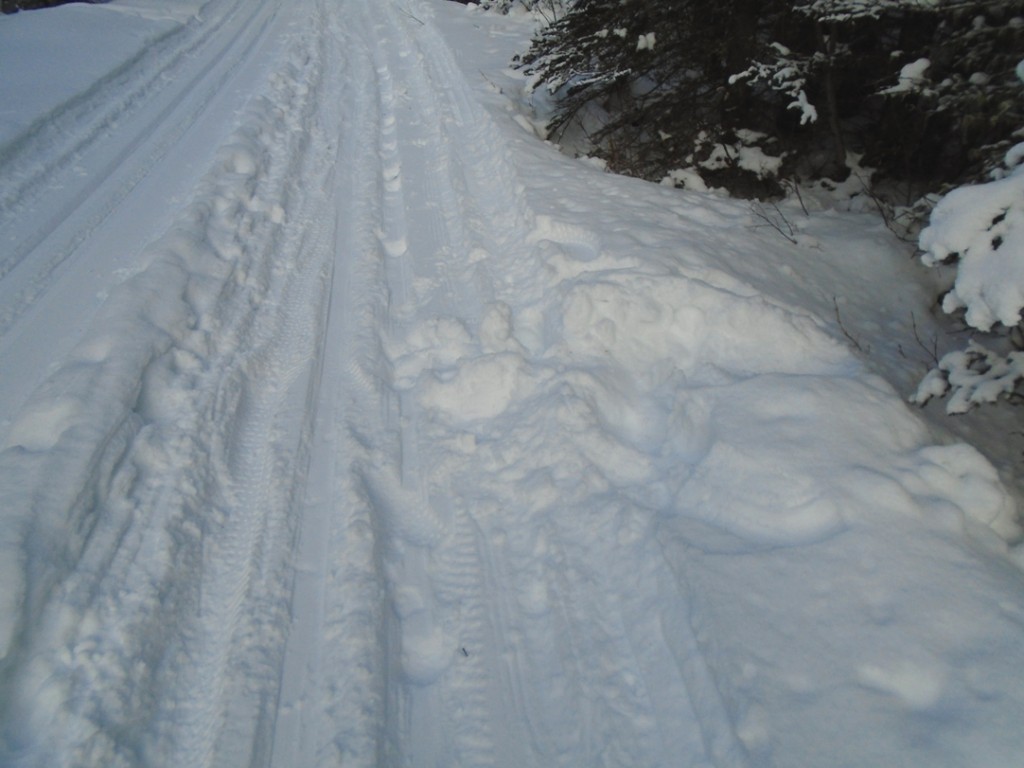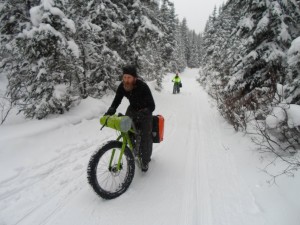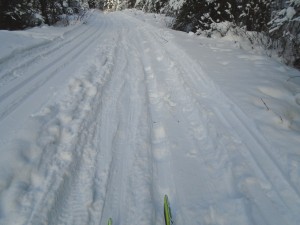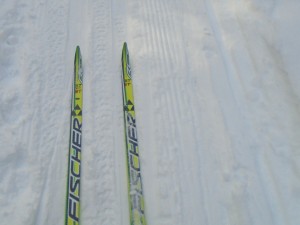Trip report from Helen: “Sadly the last 40 minutes of our ski, approaching Goat Creek, the new tracks had been damaged on both sides by some fat bikers.”
I’ve met fat bikers only twice on ski trails, and didn’t have any issues with them. They were polite and weren’t damaging the trails. Even the biker on Elk pass who wasn’t supposed to be there.
Fat bikes are allowed on Goat creek. They made a mess of the ski tracks within one day of the tracksetting.
Fat bikers ride in the ski tracks because the ridge in the middle of the track prevents them from riding where they should be.
The large ridge in the middle of the track creates a hazardous situation for skiers. On fast downhills, it’s impossible to slow yourself down because the ridge prevents skiers from snowplowing.
Banff National Park could easily remedy this situation and make the trail safer for skiers by simply grooming the entire width of the trail and getting rid of the troublesome ridge. I expect it would take an additional grooming pass.
Fat bikes are here to stay, so let’s accommodate them where it will do the least damage to the ski tracks.
This remedy would make life a lot safer for hundreds of skiers, and prevent the bikers from wrecking the tracks.
Take action – Banff National Park would like to hear from you
Please send an email to Banff National Park and let them know how you feel about this situation: banff.vrc@pc.gc.ca





Let’s remember that this is about Fat Tire Bikers… NOT… Fat Bikers!
I understand that Parks Canada is still trying to come up with a plan for where fat tire biking opportunities could be promoted and/or allowed, so this discussion is valuable.
To facilitate the sharing of trails, I would agree that removing any snow ridge between snowmobile passes should be a priority. This is more important to me than setting a classic track. If resources are limited, maybe the answer is to not set tracks on narrow trails. Where possible, it would be great to have a single track with a multi use skating type lane on the side (like in the upper Cascade).
This is probably the best compromise. One track on Goat creek would be sufficient, and it leaves lots of room for snowplowing and the “multi-users.” Great idea, Chuck.
This is exactly what is being done on two shared use trails at West Bragg Creek. East Telephone Loop is groomed full-width and has a single XC track set on the east side of the trail. This allows plenty of room for snowshoers and bikers on the west side of the trail.
Mountain Road is groomed full-width, with a single XC track set on the north side, a skate-ski lane in the middle and space for bikers, snowshoers, walkers and equestrians on the south side.
I agree with Risto that non- x-c skiers may not realize the hours and tax payers dollars that go into setting those two skinny tracks! And how their destruction can totally change the day of a skier. I think education in this regard may help the situation with fat bikers, skate skiers, hikers, etc. I also think ensuring there are good alternative trails for every sport would help as well.
I can’t help but think of the scenario of meeting a fat biker grunting up a steep trail (possibly head down), passing some uphill skiers, and I come screaming around the corner on the downhill (in a controlled snowplow, of course). There would be a lot of metal in that scenario which may create some big damage.This is my worry of sharing the ski trails with fat bikers.
That’s my 2 cents worth!
This scenario concerns me too, I recently met two bikers coming up the middle of one of the hills in WBC while I was snow plowing down, they were totally enjoying themselves, gave me a big smile and hello, but did not make any attempt to move over to the side. They were clearly unaware of, 1.they should not have been on the ski trail, and, 2. skiers need a certain amount of room when snow plowing.
In my view the idea of sharing x-c ski trails is not one that promotes safety for either party.
They were more likely not wanting to ride in tracks (which is a good thing) and not aware that you were in distress. People who say hello are generally the same type of people who would move over if they thought it was risky. They also probably could have moved over more quickly than you would expect if they thought there was a chance of collision.
When I am on skis and need to herringbone, I generally move toward the center as well.
I will throw my 2 cents in. I fat bike and xc ski. Fat biking is relatively a new sport at least in terms of being mainstream. Etiquette is still being established. I totally agree there is really no need to ride bikes in xc trac set. There are so many other trail options that this shouldn’t have to be an issue. I’m hoping this was a bit of an anomaly as most bikers, at least that I have seen seem to be more interested in the established mountain bike trail systems. Conversations like this are needed to establish some etiquette on what’s appropriate fat bike terrain. Remember fat bikers are out there for the exact same reason as skiers, it’s fun, and it’s great to be outdoors. We will get this figured out, hopefully without using terms like “ban”, but I believe both parties can co exist and love the sport they do.
People talk about “not biking in the tracks.” What about skate skiers who do not ski in the tracks, and trails that have corduroy instead of tracks?
Perhaps packing certain trails (NOT existing ski trails) for fat bikers with a narrow pack would be a good idea, so they can go fat biking on a packed trail without messing up our ski trails.
I have nothing against fat bikes but perhaps they should stay on the bike trails.
As a guy who has been fatbiking for 10 years (15 if you count 3″ semi-fat) and has never once even come close enough to a trackset to cave in the edge. I am upset about the destruction. Not only because I also ski, respect groomers, and am not a destructive type, but because it gives fatbiking a bad reputation.
First, your grooming suggestion is an excellent one for all of us. The ridge between lanes is not only a problem for this trail, but also in other places. I have crashed a couple of times trying to use my ski for braking on a center ridge.
Bob, when you took the picture on Elk Pass, there was no way for bikers to know that fatbikes were not allowed, because as far as we knew they were allowed in the winter just as in summer. I had been over Elk Pass at least a dozen times until then because it was one of only two bike trails with camping available to us. Until the man in your picture got fined by park rangers…
No one ever complained when I initially rode these (often from Pocatera), because my tracks were not only insignificant, they were not on the trackset. The banning of fatbikes from all the Kananaskis trails was an arbitrary decision by some Kananaskis staff, and this has led to the inconsistency in information regarding which trails are legal and which are not.
I have been staying off the west Kananaskis trails (on my bike) for the last few years, but it would be nice to have some better options than doing 8 laps of WBC when it comes to fatbiking. I do think that things will get better if they get the bridges back in to allow the snomobiles on to Elbow Loop again – it was a fantastic fatbike camping (fatbikepacking) loop.
The trouble is compounded by the number of new fatbikers that ride the trails with summer tire pressures – leaving a much deeper furrow than a properly set up bike.
Also, thank you for the stance on coexistence. Mutual support will get us much further than trying to have trails closed to each other. There is a substantial overlap between all the outdoor winter sports, and by cooperating we can hopefully improve things for all of us.
Two thoughts:
1- Twenty-somethings (enough said)
2- If only half of us showed some spine and told them politely (or not, depending on your personality) when we meet them, most of those fat-bikers would get the message and steer clear of our trails. Venting on an XC skiing internet forum instead won’t reach them.
“Venting on an XC skiing internet forum instead won’t reach them.” No, but writing to Banff National Park and voicing your concern may mitigate the problem. Fat biking is allowed on Goat creek, and no amount of stern, polite, or rude discourse will change the situation. -Bob
I wasn’t talking about you, Bob. You wrote an excellent piece, on your excellent blog. That’s much better than most of us including myself. But I just often see and talk to a lot of people who, in a typically Canadian fashion, bad-mouth about offenders behind their back but won’t say it to their face (on this forum for instance). I think that a fat-biker that is told (politely or not) three of four times will not enjoy his/her ride and will likely get the message and not do it again. But some people believe that government should do it for them; fine.
I have linked this forum over to Pinkbike as it is better if the two user groups come up with solutions and educate within our own groups. I don’t see what the difference is between a Fat Bike coming up a hill and a skier herring boning up the same hill are, you still have to navigate around them safely for everyone to have a fun day.
Alex were you never 20?? Not sure how relevant that comment is but you should be happy that the younger generation is out using the trails and enjoying the outdoors.
It’s quite possible that the Goat Creek riders were tourists or newbies who were ignorant of trail etiquette. Therefore, it is incumbent on the rental operators, who are promoting fatbiking at Banff, Kananaskis Village, and elsewhere, to do do a bit of education, and maybe consider not even renting out the bikes when conditions are soft.
While skiing is my main focus in winter, I ride the trails about once a week as well, only when and where conditions are firm as that is when snow riding is fun. I don’t understand what enjoyment could possibly be had by slogging up a soft flat ski trail plowing a trench, and most if not all local winter riders would agree. Hence my opening thoughts.
Reality is that fatbiking is not going away, and if they don’t self-police, then there will be a hue and cry for further restrictive regulations, the lack of which is one of the attractions at West Bragg- where trail users are basically asked just to respect others and use a bit of common sense.
As with any group, a few rotten apples tend to spoil the batch. Overall, my experience with Fat Bikers has been positive (save for the aggressive driver riding my bumper in the 40km/hr zone in Bragg Creek who then blasted past me on a double solid last weekend). The explosion of popularity with Fat Bikes and the resulting catch-up game with parks and rec management will undoubtedly create conflict. Just for fun, I skimmed a few mtb forums on Fat Bike trail edequite. The majority of commenters displayed good judgement and advocacy of being good stewards for the sport. Not riding in tracks, yielding to skiers, abstaining from riding on soft grooming, etc. However, there were also a smaller group who left comments that were less than cordial and insulting to anyone who appreciates the efforts of groomers and xc skiers alike.
I think fat bikes and skiers can coexist. At West Bragg Creek, the (mostly) separated trails work great. Last weekend at Ribbon creek (multiple trails), there had obviously been quite a bit of fat bike use. The snow conditions (great but thin, firm packed) and wide grooming (easy for them to stay clear of the tracks) meant that they had, in my opinion anyway, absolutely no impact on ski conditions. Deep snow and fresh trackset – it would have been a mess.
I don’t think fat biking is a short term fad. Polite conversation with bikers we encounter, and communication with PC/AB Parks etc is going to be important.
I was just looking online for where and where not fat bikes are permitted. The Rebound bike shop lists the Goat Creek trail as a “go to” trail.
The last two weekends I have been to Ribbon and seen fat bikers on Skogan and Kovach.I cannot find online whether fat bikes are permitted or banned from Ribbon, except for the old Ribbon trail. Anyone know what the policy is here?
Kelly
Here are the Parks regulations concerning Fats: http://www.albertaparks.ca/kananaskis-country/activities-events/winter-activities.aspx
Fat Biking
Fat biking at the Canmore Nordic Centre is only permitted on designated single track trails marked with fat bike signage.
EKG East*
EKG
Blue Coal Chutes
Long Road to Ruin
Orchid
Canmore Trail (double track – part of snowshoe loop and winter disc golf course)
Georgetown Trail (double track)
* To protect wildlife and reduce wildlife encounters, all trails above EKG East (ie. Killer Bees, Ziggy’s, Nectar Noodle, The Backdoor, The Albertan) are closed from December 1 – June 15.
Fat Biking is NOT permitted currently on any other groomed trail in Kananaskis Country.
Not sure what the Parks status of Goat Creek is but since it is groomed by K Country staff that would make it a no go.
As a former groomer in Calgary you just can’t do another pass of the equipment as you have to go out and back so it doubles the grooming time. The longest aspect of grooming is packing not track setting. A possible solution is to drag a wider renovator.
Some signage at the trailhead may help, but I personally dislike signs.
“you just can’t do another pass of the equipment” Why not? Of course it’s possible and should be done. I thought it was obvious that “another pass” on a one way trail would mean an “out-and-back.” -Bob
Opps, I just read Bob’s first article about K Country not grooming Goat Creek!! Well at least you have the regs for the trails there now. I did search for the NPC regulations on Fat Bikes and was unable to find anything on their website, a call to Banff would most likely clarify this issue.
Thanks Bruce. I was not sure I could say anything to the fat bikers on the groomed Ribbon trails but I will speak up next time I see them there. I don’t want to get into an altercation out there so I will politely refer them to the website you posted.
I guess a person has to be very diplomatic about the whole issue, like is it worth it right at this moment to talk to them if they are just out having a fun day and not riding right up the track set. They are as passionate about riding as you are about skiing. On a whole Albertans are not very good about being told what they should do!!
Bob, what I really meant was as it is a long trail they most likely drive out and back once towing the renovator. Doing another trip would double the grooming time. If they had a wider renovator, i.e. a Ginzu, they could still achieve a wider trail with two passes.
I don’t think the narrow bridges would accommodate a wider renovator. -Bob
…Lump in my throat looking at that track destruction.
My experience has been that those who don’t cross country ski are completely oblivious to how valuable those tracks are to skiers. Better signage (and fines for violations for those that still don’t get it) would go a long way.
I also completely agree about that ridge on Goat Creek. Makes the trail very un-skiable later in the season when the trail has frozen.